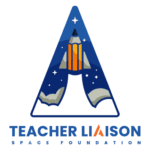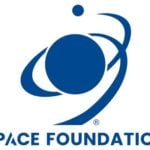Education
Eighth Grade Science Teacher is 2017 Recipient of the Alan Shepard Technology in Education Award
Written by: developer
Ashlie Blackstone Smith, an eighth grade physical science teacher at Cranbrook Kingswood Middle School for Girls, in Bloomfield Hills, Mich., has been selected by the Astronauts Memorial Foundation (AMF), the National Aeronautics and Space Administration (NASA) and the Space Foundation as recipient of the 2017 Alan Shepard Technology in Education Award.
The award is given annually in recognition of creative and innovative use of technology by K-12 educators, or district-level education personnel. The award, named for Mercury and Apollo astronaut Alan Shepard, will be presented during the 33rd Space Symposium opening ceremony on April 3 at The Broadmoor in Colorado Springs, Colo., USA. The opening ceremony is co-sponsored by Northrop Grumman, and the award presentation will be followed with a by-invitation reception co-hosted by the Astronauts Memorial Foundation.
The Space Foundation’s annual Space Symposium is the premier gathering of all sectors of global space leadership, attracting thousands of participants from dozens of countries. Visit https://www.spacesymposium.org/ for complete conference information.
About Ashlie Blackstone Smith
Smith has been a physical science teacher at Cranbrook Kingswood Middle School for Girls since 2003. Among her achievements there, she:
- developed 100+ science content videos that have resulted in a flipped classroom year-long experience for students. Student achievement, engagement and class time have increased, allowing more time to incorporate additional laboratory exercises and technology such as iPads, 3D printing and coding.
- created and implemented lessons incorporating technology such as augmented reality, 3-dimensional design, computer coding and programmable robotics. This resulted in student augmented periodic tables, 3-dimensionally printed atomic structures (via software Tinkercad and Autodesk I23D), coded video games (via software GoogleCS First) and robotic programming (via Sphero).
- led a middle school innovation committee in charge of facilitating the push for innovative curriculum into the classroom including maker spaces and design-thinking practices. Actions will result in the implementation of a multi-million dollar innovation center on campus, professional development for staff, and a collaboration with the Massachusetts Institute of Technology’s Edgerton Center to deliver design thinking workshops to faculty and other schools.
- facilitated Cubes in Space program (www.cubesinspace.com) supported by idoodlelearning, inc, as well as the Colorado Space Grant Consortium, NASA Wallop’s Flight Facility and Langley Research Center, Lockheed Martin and CaptainJudy.com. Outcomes of past programs have led to studentdesigned experiments launched on sounding rockets and high-altitude balloons.
- facilitated Cassini Scientists for a Day program sponsored by NASA and the Jet Propulsion Laboratory.
- co-designed and implemented annual, month-long Math/Physics Olympics program. Sixty female student participants plan and design tennis ball catapults, egg-catching devices, musical instruments, Sphero robotic coding, specially designed Pringle chip packages and structures for day-long competition.
- facilitated You Be the Chemist program sponsored by the Chemical Educational Foundation and Dow Chemical Company. Possible outcomes for students include local, state and national competitions based on chemistry with college scholarship opportunities.
Smith earned a Bachelor of Science degree in environmental biology/zoology from Michigan State University in 2000, and a Master’s degree in secondary science education from Wayne State University in 2005.
About Space Foundation STEM Programs
The Space Foundation is helping to build the next generation of space leaders, and improving the overall quality of education, through teacher, student and community programs that use space themes to improve students’ interest and skills in science, technology, engineering and mathematics (STEM). Space Foundation grassroots outreach helps communities to develop a Pre-K through 20 STEM pipeline, to grow a community’s organic workforce and to strengthen economic development. To learn more about Space Foundation STEM education programs, visit https://www.discoverspace.org/.
About the Astronauts Memorial Foundation
Founded in the wake of the Challenger accident in 1986, AMF honors and memorializes 24 astronauts who sacrificed their lives for the nation and the space program while on a U.S. government mission or in training. AMF, a private, not-for-profit organization, built and maintains two major facilities at the John F. Kennedy Space Center Visitor Complex. The Space Mirror Memorial is a 42-foot high by 50-foot wide polished granite monument designated by Congress to be the national memorial for America’s astronauts. At the Center for Space Education AMF partners with NASA to inspire future generations of scientists, technologists, engineers and mathematicians. Students, teachers and mentors experience building rockets, robotic competitions and other hands-on space-related learning activities led by AMF space education specialists. The recent completion of extensive renovations at the CSE created a massive conference space with state-of-the-art audio/visual capabilities. Over 750 people attended the 2017 NASA Day of Remembrance Apollo 1 Tribute ceremony in this newly refurbished space, and NASA’s annual Robotic Mining Competition involving over 500 students from almost 50 colleges throughout the nation will be utilizing this space in May. For more information about AMF visit www.amfcse.org.
About the National Aeronautics and Space Administration
NASA is an agency of the United States government, responsible for the nation’s civilian space program and aeronautics and aerospace research. Operational since 1958, NASA’s mission is to pioneer the future in space exploration, scientific discovery, and aeronautics research. It has led U.S. space exploration including the Mercury and Gemini space programs, the Apollo missions to the Moon, the Space Shuttle, U.S. involvement in the International Space Station, the Hubble Telescope and robotic interplanetary and distant space missions. NASA is also responsible for long-term civilian and military aerospace research and research focused on better understanding Earth, the solar systems, and the universe beyond. For more information, go to www.nasa.gov.
This article is part of Space Watch: March 2017 (Volume: 16, Issue: 3).


